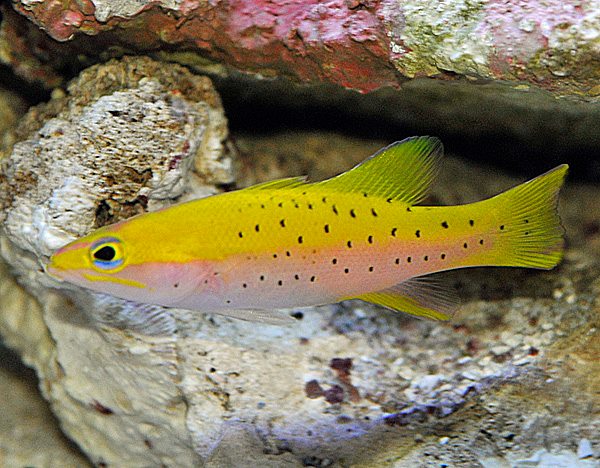Liopropoma has been a much talked about genus here, especially in the last few months. With Liopropoma fasciatum claiming fish of the year and L. aberrans making a scene in Singapore, our obvious love for this genus is poorly concealed. We even have a pretty extensive magazine article on this genus as a whole where we go into the details on their husbandry and seclusive lifestyle. Perhaps we were too quick in singing praises about L. fasciatum and how it’s quite unlikely another species would overthrow its status so soon, because just last week De Jong marine released what is most likely the first ever photograph of a sub-adult Liopropoma lunulatum.
You might have seen the images and updates from De Jong by now, making its rounds around Facebook and other metaphorical grape vines. We apologise for this rather delayed update. As they say, too many cooks spoil the broth and a little mix up in the departments left this post a little lost and forgotten. Regardless, Liopropoma lunulatum is not a new fish on the scene, and while it may not be as exciting as the meteoric appearance of L. fasciatum in the trade, the former is still by far one of the rarest and most elusive members of the genus.
Liopropoma lunulatum is a large species, capable of attaining a maximum size exceeding six inches. The fish is very roughly two toned, with the dorsal half a bright sunrise yellow and the ventral half a rich salmon. The two colours mix very homogeneously along the lateral half of the fish, and the body is peppered haphazardly and sparsely with black flecks.

Not much is known about the biology of this fish, and no photos of it living in situ have ever been provided. It has a wide range across the Indo-Pacific, being found in both the Pacific and Indian ocean portions. Like most Liopropoma, L. lunulatum is found at substantial depths where it is almost never seen by conventional diving. That is also compounded by their rather secretive habit, preferring to lead a cloistered life within the calcareous catacombs of their reef labyrinth.
As such, very few specimens have ever been captured, and those that do never make it to term. In 2011, an adult L. lunulatum was caught by CV Neptune Marine in the Celebes Sea, where it subsequently died from decompression issues. Very rarely, divers may encounter an odd individual at the limits of their diving range and proceed to capture it, but failure to decompress the fish often leads to their demise.
As you know, deepwater fish are plagued by buoyancy issues caused by inadequate or rather improper techniques of decompression. Conventional needling of the swim bladder is most often employed, but sterility is a cause for concern and may pose a significant risk of infection of the wound post collection. Trauma as well as improper lancing techniques may also destroy the functionality of the bladder, and this often results in the fish having multiple bouts of “buoyancy related relapse” even after appearing fine for the first few weeks. If you’re interested in knowing more about this issue, and what kinds of environmental changes may exacerbate a relapse, I participated in a Q&A session with biologist Matt Wandell of Steinhart Aquarium and Caitlin Goldenberg of reefs.com in a video dialogue here.

Over the years, a handful of this species have been caught, most of the time by accident. Trawler fishing as well as reel lines are often the main methods of obtaining these deepwater fish, and as you know these traumatic methods of fishing almost always result in eventual death. L. lunulatum join the ranks of a few other similarly elusive species that are only brought to light by such methods. One such fish is Liopropoma randalli.

It therefore comes as a huge surprise that after so many years, a single specimen in picture perfect health has been collected and properly decompressed. What’s even more surprising is the size of this individual, measuring in at just about three inches. The small specimen was collected in the Maldives along with Liopropoma latifasciatum, although we’re unsure of the exact depth. It’s the first time this species has entered the trade from the Indian Ocean, with previous specimens being caught from Indonesia.
This first look at a small sized specimen shows its difference in the adult coloration as well. The separation of the two tones are also more defined and less mixed, and it’s clearly not as intense. If you’re sharp enough, you would have also noticed that adults of L. lunulatum have the salmon portion of the body creeping up toward the head, where it is contrasted by a yellow eye-stripe that branches off from the yellow top half. Juveniles lack this eye stripe pattern.
The single specimen from De Jong Marine is now scheduled for arrival at, surprise, BlueHarbor of Osaka. No word yet on where the final destination lies for this fish, but we heard that Dr. Shimokobe, deepwater fish enthusiast has his eye on it. One thing’s for sure, we’ll definitely be seeing more of this guy in the months to come.



